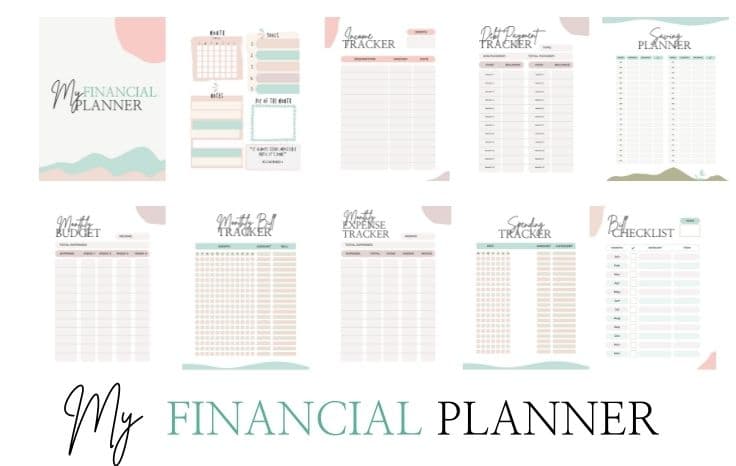Sharing is caring!
If you are looking for a new way to easily organize your finances, this printable financial planner gives you all the tools you need to start!
Even if you’ve failed at keeping your finances in order this finance workbook will finally help you get control of your money AND help you stay consistent.
On my journey to becoming debt free I struggled with keeping track of my finances. I tried all the things but there were too many bills to pay at different times, there was inconsistent income, and unexpected expenses. These all threw me for a loop and I gave up countless times.
I finally got so angry and frustrated that I decided enough was enough and I sat down and developed a system that made sense! It was simple and laid out all the pieces of the puzzle to help me get a clear view of my financial state so I could create realistic financial goals to help me achieve financial freedom!
Using this system, I was able to pay off all our debt and become a stay at home mom. That was 10 years ago and we still pay in full for everything and have not acquired any new debt. I was able to stay home for 2 years with our kids and returned to work when I was ready, not because I had to.
I’m telling you this because this system works! Check out the printable financial planner here.
Printable Financial Planner
This planner is set up as a 12 month planner and for each month the budget planner includes:
- Income Tracker
- Savings Planner
- Debt Payment Tracker
- Monthly Budget
- Monthly Expense Tracker
- Monthly Bill Tracker
- Spending Tracker
- Savings Tracker
- Debt Payoff
- Bill Check List
Here is the exact steps I went through when setting up my financial planner.
Step 1 – Income Tracker
Detail all your expected income. If you have a variable income, look over the past few months and consider what your income might be based on your lowest expected income.
Step 2 – Monthly Bill Tracker
Review all your bills. These are your basic expenses. This includes utilities, rent or mortgage payments, groceries, child care, and minimum debt payments. You can check out this complete list of budget categories to see exactly what bills you should include so you don’t have surprises during the month.
Step 3 – Monthly Bill Tracker/Bill Check List
Use these sheets to track when your bills are due and check off when you pay so you know it’s already complete. If you have auto payment set up for some accounts, you can track the amount of payment here to help you notice trends in your bills. This is also a great way to find if there are ways to cut down on these bills.
Step 4 – Debt Payment Tracker
Keep track of all your bills and any payments you make towards your debt. This was so key for us because we were able to see our progress, even if it sometimes felt like we weren’t making progress.
Step 5 – Savings Tracker
Use the savings tracker to help you slowly save up for bigger purchases or to build an emergency fund!
Step 6- Monthly Budget
Write down your monthly income and expenses including your debt payment and planned savings all in one place. Not only can you return to your monthly budget to make sure you’re on track throughout the month, but you can also use this monthly budget to adjust your future budgets.
Step 7 – Expense Tracker/Spending Tracker
Every time you make a purchase or pay a bill WRITE IT DOWN! I don’t care if you spent $1.00 at the vending machine for a bottle of water, you need to keep track of all your spending. You can do this at the end of each day or each week but don’t wait until the end of the month to see how much you spend. The more frequently you write down your expenses and calculate how much money you have left for the month the less likely you will run out of money at the end of your pay period or month.
This financial journey is yours and your budget and financial planner should reflect that. Take the time to use one of the monthly planner pages to set some goals and design a plan for YOU!
Check out the Financial Planner on Etsy and get started on the road to financial freedom right now!





